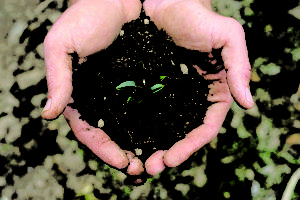 MGG’s Ryan Anderson covers the amazing life and diversity found in the place you’d least expect: your lawn’s soil.
MGG’s Ryan Anderson covers the amazing life and diversity found in the place you’d least expect: your lawn’s soil.
The most bio diverse ecosystem on earth does not reside in the Great Barrier Reef or the Amazon. NO, it lives right in your backyard! Just one cup of soil can contain 200 billion bacteria, 20 million protozoa, 100 thousand nematodes, and 50 thousand arthropods.
The soil in your yard holds amazing complexity and diversity that will make or break your natural lawn depending on how you care for it. When treated and maintained well, beneficial soil organisms thrive and improve turf health by decomposing organic matter, cycling nutrients, strengthening soil structure, and controlling diseases and pests. When mishandled, you create a haven for unwanted weeds, grass killers, and disease.
When managing turf, stop thinking how to achieve a “green” lawn, and start implementing strategies that best treat the whole living soil organism/web that provides for your grass. Vital soil microorganisms, nematodes, earthworms, and arthropods flourish in nutrient-rich, porous, and well-moisturized organic matter.
In line with our Natural Lawn Care Calendar, MGG identifies three strategies to build vibrant and life-producing organic matter for May:
- Avoid compacted soil by aerating it- No one likes to feel constricted; neither do the organisms living in your soil! Compacted soil restricts air access, growth ability, and water uptake capacity of all living organisms including your turf’s roots. Causes of soil compaction include heavy foot traffic, home construction, and/or heavy rain and sprinkler irrigation. Prevention techniques, such as building walkways to steer foot traffic away from turf, will improve living conditions, but every once in a while you will need to loosen the soil by aerating it. A well aerated soil enables air, water, and nutrients to freely diffuse into your lawn. The frequency you should aerate the soil depends on the lawn’s soil type, foot traffic, and desirable appearance. We recommend aeration at least once in May and September, but some soils (i.e. low traffic and sandy soils) may not even need treatment.
- Amend your soil with compost, humus, and worm castings- I always tell lawn care managers that healthy soil requires 16 essential nutrients and a loose, porous structure that boosts its water and nutrient carrying capacity. Simply applying synthetic fertilizers will not create this desirable soil environment, since they often provide only three of the essential nutrients (nitrogen, phosphorous, and potassium) and add no value to soil texture and drainage. When thoroughly mixed in to the whole soil structure, soil amendments of compost, humus, worm castings, and other materials contribute needed nutrients, while improving the soil’s physical properties of aeration and water retention, infiltration, and drainage. For turf, responsibilities for mixing these materials into the soil fall on the soil’s microorganisms. Top-dressing your lawn with a ¼-inch layer of compost will rejuvenate microorganism life in your soil. For applying compost to lawns try to use particle sizes less than 3/8-inches so the organic matter can more easily travel between grass blades and avoid smothering the grass. Dry compost may amend your soil over a period of time, but if you want to speed the process look to compost tea.
- Refrain from applying unneeded pesticides- I can’t represent Midwest Grows Green without mentioning pesticides, right?!! Pesticides, which include fungicides, insecticides, and herbicides, are designed to kill living things. So, it should not surprise you that these chemicals can seep into the soil and kill/harm living organisms, particularly vital microorganisms. In addition to killing microorganisms, pesticides have altered their enzymatic activity and inhibited their nitrogen fixing ability.
